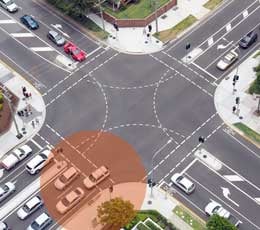Queue Monitoring - An exciting new insight
Queue Monitoring
Queueing is an exciting new insight Mooven has recently launched. So what is it and how do you use it? Below are some real world use cases we often come across, that you may find quite applicable.

Construction Projects
Understanding the impact of roadworks or construction activity on the surrounding network can be a challenge. Congestion can occur in adjacent areas and even if you're on site you can't see all areas from a single location.
While some congestion around worksites is unavoidable, conditions can quickly spiral out of control if queues start to clog up adjacent intersections.
We have been using queue monitoring to solve the following challenges:
Tracking congestion on critical areas like highway onramps, intersections that back onto major corridors or other sensitive areas. When you have stakeholders that have localised concerns, providing visibility of when, where and how long queues are helps to either alleviate their concerns or clarify the issue.
Alerting to notify feed staff of excessive queues so they can trigger a timely intervention. Where possible, mitigation plans are prepared in advance with work crews and local authorities. Commonly used mitigations include temporarily stopping work and flushing traffic through, or contracting the traffic operations centre to temporarily adjust signal phasing.
Manage directional imbalances when running a contraflow setup through the use of queue monitoring, is an effective way to improve the performance of your temporary traffic management setups. There can often be temporary spikes in traffic that are hard for field staff to judge. Real-time alerts can be used to notify field staff of excessive queues on individual approaches so they can adjust their approach.
Network Optimisation & Management
Gaining visibility of queue length is also an invaluable tool when optimising the performance of a network, in particular when looking to determine if changes to signal phasing or capital improvements have worked.
We have been using queue monitoring to solve the following challenges:
Validating feedback on intersection performance. When complaints come through about excessive congestion or queues preventing access it's important to gain objective information so that an appropriate response can be made. This is always the first step.

Once problem segments are identified and the link between different areas is understood, signal phasing is adjusted accordingly. There are generally 2 approaches; providing more time for downstream congestion points to allow sufficient space for new vehicles, or restricting the volume of new vehicles entering the area.
When conducting these changes you want to ensure there is sufficient space for new vehicles so they don't sit within the intersection, resulting in intersection failures and the associated safety issues.Actual performance can be quite different from what you'd expect to happen so the next step is to watch how the change impacts conditions. This is the most valuable step as it encourages learning and continuous optimisation to achieve the best result. It also opens up the potential of running more unorthodox experiments and testing how they perform.
Virtual, advanced detector loops are where we're looking to expand to next. As a deeper understanding of the trigger points is gained, digital monitoring could be put in place to identify when conditions are escalating. When this occurs, either a network operator could be notified or, ideally, a direct feed into systems like SCATS could be setup to trigger a predetermined alternate phasing, proactively addressing the issue in real-time.
If you are grappling with any of these challenges, we're happy to share more information on the methodologies we are using to influence the delivery of projects. Simply get in contact with us or find a time for us to meet.

Smart VMS
Mooven releases self-service smart VMS
Date

Safety
Celebrating a risk-based approach to road safety
Date

Blog
Travel Time Monitoring for Road Infrastructure Projects
Date
